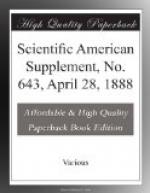[Illustration]
It was not many years ago that an inventor of a siphon noticed how water could be drawn up hill with a lamp wick, and the thought struck him that with a soaking arrangement of this kind in one leg of the siphon a flow of water could be obtained that would always be kept in motion. Without taking a second thought he dropped his work in the hay field, and ran all the way to London, a distance of twenty miles, to lay his scheme before a learned man of science. He must have felt like being carried home on a stretcher when he learned that a performance of this kind was a failure. Among the others who have given an exhibition of this kind we notice an observer who was more successful. Being an overseer in a cotton mill, he had only to run over to his dining room and secure two empty fruit jars and pipe them up, as shown. He had had trouble in measuring volume by the liquid process by having everything he attempted to measure get a thorough wetting, and there were many substances that were to be experimented upon that would not stand this part of the operation, such as fibers and a number of pulverized materials. One of the jars was packed in tight, nearly half full of cotton, and the other left entirely empty. The question now is to measure the volume of cotton without bringing any of the fibers in contact with the water. The liquid is poured into the tunnel in the upright tube under head enough to partially fill the jars when the overflow that stands on a level with the line, D E, is open to allow the air in each jar to adjust itself as the straight portions are wanted to work from. The overflow is then closed and head enough of water put on to compress the air in the empty jar down into half its volume. It may take a pipe long enough to reach up into the second story, but it need not be a large one, and pipes round a cotton mill are plentiful. In the jar containing cotton the water has not risen so high, there being not so much air to compress, and comes to rest on the line, C. Now we have this simple condition to work from. If the water has risen so as to occupy half of the space that has been taken up by the amount of air in one jar, it must have done the same in the other, and if it could have been carried to twice the extent in volume would reach the bottom of the jar in the one containing nothing but air, and to the line, H I, in the jar containing cotton.
The fibers then must have had an amount of material substance about them to fill the remaining space entirely full, so that a particle of air could not be taken into account anywhere. The cotton has produced the same effect that a solid substance would do if it just filled the space shown above the line, H I, for the water has risen into half the space that is left below it. This enables an overseer to look into the material substance of textile fibers by bringing into use the elasticity of atmospheric air, reserving the liquid process for measuring volume to govern the amount of compressibility.—Boston Journal of Commerce.




